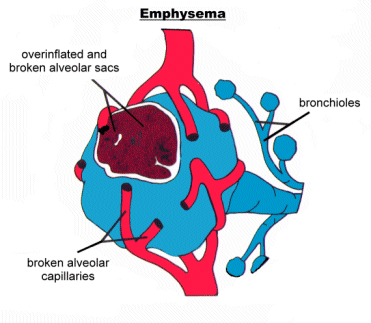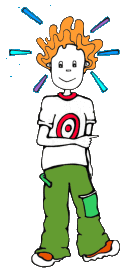|
EMPHYSEMA
 Emphysema is a slowly progressing (chronic) destruction of the lungs which makes
breathing very hard to do. It occurs in about 7% of people over the age of 50. When the small
air-carrying tubes (bronchioles) become filled with mucus, air gets trapped in the grape-like
clusters (alveoli) found at the end of these tubes. These tiny air sacs in the lungs may pop open.
With broken air sacs, the lungs can not exchange oxygen for carbon dioxide efficiently. As well,
the elastic tissue which allows the lungs to stretch gets destroyed. Without stretchy fibres,
the lungs find it difficult to expand and contract. At first, it may only be difficult to breathe
at certain times of the day or during certain activities. Eventually, though, as less and less
oxygen is transferred to the blood stream, difficult breathing becomes a regular occurrence. Emphysema is a slowly progressing (chronic) destruction of the lungs which makes
breathing very hard to do. It occurs in about 7% of people over the age of 50. When the small
air-carrying tubes (bronchioles) become filled with mucus, air gets trapped in the grape-like
clusters (alveoli) found at the end of these tubes. These tiny air sacs in the lungs may pop open.
With broken air sacs, the lungs can not exchange oxygen for carbon dioxide efficiently. As well,
the elastic tissue which allows the lungs to stretch gets destroyed. Without stretchy fibres,
the lungs find it difficult to expand and contract. At first, it may only be difficult to breathe
at certain times of the day or during certain activities. Eventually, though, as less and less
oxygen is transferred to the blood stream, difficult breathing becomes a regular occurrence.

CAUSE
What is the biggest cause of Emphysema? CIGARETTE SMOKING! Non-smokers rarely get it.
A few people are born lacking a protective substance called the alpha-1 antitrypsin (AAT).
AAT deficient persons, even non-smokers, are more likely to suffer from emphysema, at as young an
age as 30 or 40 years, because they lack the material necessary to prevent to destruction of alveoli of the elastic fibres.
The bronchioles in our lungs look like the branches of an upside down tree.

They gradually become smaller and end in a cluster
of very thin-walled air sacs which look like a bunch of grapes. Here, oxygen from the air that we breathe, squeezes through into the blood-carrying
capillaries which have wrapped themselves around these sacs. Red blood cells, floating in the blood, are waiting to grab the
molecules of oxygen and to let go of the carbon dioxide which they have brought back to the lungs to be
breathed out.
The lungs like to keep themselves very clean. When people smoke, smoke and tar enter the lungs making them dirty.
Mucus phlegm is produced in the tubing to help trap this dirt and it must be brought up and spit out. If smoke and tar
reach the alveoli, special cells macrophages try to eat this foreign material. But dirty
smoke can overwhelm these cells, and they may burst. Some of the chemicals released will start to eat the walls of the alveoli
forming enlarged, limp sacs or leaving holes in the lungs. The lungs are no longer tightly sealed and it is much
harder to breathe. Heart failure may develop when this disease has gone on for a long time because the heart must work harder to push
oxygen around the body.
TREATMENT AND PREVENTION
Antibiotics are used to combat chest infections which sometimes accompany emphysema. Patients should also receive
a yearly influenza vaccination. Regular exercise can strengthen muscles and let people be more active. Likewise, a good nutrition
is important to provide the body with needed energy. A doctor may prescribe medications which enlarge the bronchioles to help keep the
air passages open. Some patients benefit by breathing additional oxygen. With advances in medical technology, lung transplants are a
possibility for a small number of patients for whom other treatments no longer work.
 The most effective way to combat emphysema is through prevention. Once our lungs are damaged, it is impossible to totally repair
them. Since smoking is the major cause of emphysema, staying smoke-free is the first step toward healthy lungs.
This will prevent the destruction of the lungs caused by cigarette smoke. We cannot make new lungs, so save the ones you have! The most effective way to combat emphysema is through prevention. Once our lungs are damaged, it is impossible to totally repair
them. Since smoking is the major cause of emphysema, staying smoke-free is the first step toward healthy lungs.
This will prevent the destruction of the lungs caused by cigarette smoke. We cannot make new lungs, so save the ones you have!
DON'T SMOKE!
 For additional information, check out the Canadian Lung Association's web site. For additional information, check out the Canadian Lung Association's web site.
|



This digital collection was produced under contract to Canada's Digital Collections program, Industry Canada. The web site was produced by a youth team at the Saskatchewan Lung Association.
